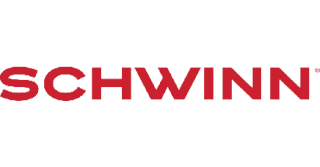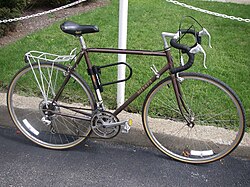
A bicycle frame is the main component of a bicycle, onto which wheels and other components are fitted. The modern and most common frame design for an upright bicycle is based on the safety bicycle, and consists of two triangles: a main triangle and a paired rear triangle. This is known as the diamond frame. Frames are required to be strong, stiff and light, which they do by combining different materials and shapes.

A derailleur is a variable-ratio bicycle gearing system consisting of a chain, multiple sprockets of different sizes, and a mechanism to move the chain from one sprocket to another.

Shimano, Inc., originally Shimano Iron Works (島野鐵工所) and later Shimano Industries, Inc. (島野工業株式会社), is a Japanese multinational manufacturing company for cycling components, fishing tackle and rowing equipment, which also produced golf supplies until 2005 and snowboarding gear until 2008. Named after founder Shozaburo Shimano and headquartered in Sakai, Osaka Prefecture, the company has 32 consolidated and 11 unconsolidated subsidiaries, with the primary manufacturing plants based in Kunshan (China), Malaysia and Singapore.

The Schwinn Bicycle Company is an American company that develops, manufactures and markets bicycles under the eponymous brand name. The company was founded by Ignaz Schwinn (1860–1948) in Chicago in 1895. and became the dominant manufacturer of American bicycles. Schwinn first declared bankruptcy in 1992 and was restructured, in 2001 Schwinn again declared bankruptcy and was purchased by Pacific Cycle, now owned by the Dutch conglomerate, Pon Holdings.
Colnago Ernesto & C. S.r.l. or Colnago is a manufacturer of road-racing bicycles founded by Ernesto Colnago near Milano in Cambiago, Italy. It remained a family-controlled firm until May 4, 2020, when it was announced that the UAE-based investment company, Chimera Investments LLC, had acquired a majority of the Colnago shares from Ernesto Colnago, although the headquarters will remain located in Italy after the acquisition. Instead of following his family's farming business, Ernesto Colnago chose to work in the cycle trade, and was apprenticed first to Gloria Bicycles at the age of 13, and subsequently taking up road racing. After a bad crash ended his racing career, he began subcontracting for Gloria, and opened his own shop in 1954, building his first frames the same year. While building frames, he remained much in demand as a racing mechanic. He was second mechanic on the Nivea team Giro d'Italia under Faliero Masi in 1955, eventually being employed as head mechanic for the Molteni team of Belgian cycling legend Eddy Merckx in 1963.

Motobécane was a French manufacturer of bicycles, mopeds, motorcycles, and other small vehicles, established in 1923. "Motobécane" is a compound of "moto", short for motorcycle; "bécane" is slang for "bike."
Dawes Cycles is a bicycle manufacturer based in Castle Bromwich, England. Dawes produces a range of bikes including road, mountain bikes and tandems, but is best known for touring bikes, specifically the Galaxy and the Super Galaxy model lines.
SR Suntour is a Taiwanese manufacturer of bicycle components, formed in 1988 when Osaka based SunTour (Maeda) went bankrupt and was purchased by Sakae Ringyo Company, a major Japanese maker of aluminum parts, particularly cranks and seat posts. SunTour's sales and commercial success peaked from the late 1970s to the mid-1980s.

Tom Ritchey is an American bicycle frame builder, Category 1 racer, fabricator, designer, and founder of Ritchey Design. Ritchey is a US pioneer in modern frame building and the first production mountain bike builder/manufacturer in the history of the sport. He is an innovator of bicycle components that have been used in winning some of the biggest cycling competitions in the world including the UCI World Championships, the Tour de France and the Olympics. In 1988, Ritchey was inducted into the inaugural Mountain Bike Hall of Fame in Crested Butte, Colorado : and 2012, inducted to the United States Bicycle Hall of Fame in Davis, California.
Keith Bontrager is a motorcycle racer who became a pioneer in the development of the modern mountain bike. Between 1980 and 1995, he was president of his own Bontrager Company, which continues to develop components for Trek Bicycle Corporation after Trek bought out Bontrager.

Lugged steel frame construction is a method of building bicycle frames using steel tubing mated with socket-like sleeves, called lugs. For most of the bicycle's history, steel has been the primary material for bicycle frames, with lugged construction the primary assembling method. Steel continues in use by builders of high-quality steel frames, though its dominance as a frame material has waned since the mid-1990s displaced largely by aluminum and carbon fiber; lugging has been displaced by TIG welding.

The Panasonic Sport Deluxe is a road sport bicycle by National, which was exported to the United States from 1971 to 1989. Originally built in Osaka, Japan, later bikes may be either of Japanese or Taiwanese origin.
Univega is a bicycle brand created during the bike boom of the 1970s by Ben Lawee (1926–2002), who founded Lawee Inc. to design, specify, and import bicycles initially manufactured in Italy by Italvega, and subsequently in Japan by Miyata.

Nishiki is a brand of bicycles designed, specified, marketed and distributed by West Coast Cycle in the United States, initially manufactured by Kawamura Cycle Co. in Kobe, Japan, and subsequently by Giant of Taiwan. The bicycles were first marketed under the American Eagle brand beginning in 1965 and later under the Nishiki brand until 2001.
Centurion was a brand of bicycles created in 1969 by Mitchell (Mitch) M. Weiner and Junya (Cozy) Yamakoshi, who co-founded Western States Import Co. (WSI) in Canoga Park, California to design, specify, distribute and market the bicycles. The bikes themselves were manufactured initially in Japan by companies including H. Teams Company of Kobe and later in Taiwan by companies including Merida. The Centurion brand was consolidated with WSI's mountain bike brand DiamondBack in 1990. WSI ceased operations in 2000.
Cycles Peugeot, founded in 1882, is a manufacturer of bicycles based in Sochaux, France and currently a part of Cycleurope, a subsidiary of Sweden-based firm Grimaldi Industri.

KOGA is a Dutch bicycle manufacturer based in Heerenveen, Friesland. The company is known for its long time partnership with Japanese frame manufacturer Miyata, producing bicycles and sponsoring racing teams under the brand name Koga Miyata. As of May 2010 the partnership ended and the company began manufacturing bicycles under the KOGA brand.

The Schwinn Paramount was a high-end racing bicycle produced under the Schwinn Bicycle Company brand from 1938 through 2009.















